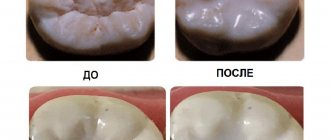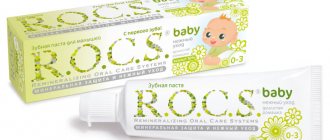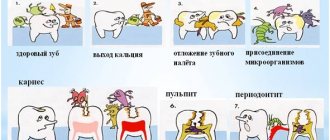What are dental fissures
There are fissures on both baby teeth and permanent teeth.
These are physiological folds - grooves, dimples and depressions - on the chewing surface of molars and premolars. The incisors and canines do not have fissures. Such cavities easily and quickly fill with plaque, are poorly cleaned with toothpaste and a brush - they become a common cause of carious lesions. Pediatric dentists often suggest sealing fissures - creating a thin film on the surface of the crown that will protect against pathogenic microflora and mechanical damage.
There are two main reasons for fissure sealing:
- Children's inability to take good care of their teeth. Even the most responsible child is not able to clean all the cavities on the surface of molars and premolars, which leads to the development of caries and the need for treatment. Especially if the grooves differ in depth and tortuosity.
- Thin enamel of teeth - milk and permanent during the period of change of bite. The thickness of the enamel of temporary units is half that of permanent ones, which explains its rapid destruction and susceptibility to caries. During eruption, molars are especially vulnerable - initially the crowns are covered with thin, slightly mineralized enamel, and only after 2-3 years the surface becomes resistant to external damage.
Rodikova Tatyana
Before recommending invasive fissure sealing to a patient, I always look at the initial level of mineralization. With a high mineral content and wide grooves, sealing cavities can be easily done without sealing, but there are cases (low mineralization, prone to caries) when sealing the teeth is the best option!
Coating teeth with enamel
Many patients come to dental clinics complaining of increased sensitivity and ask the doctor to coat their teeth with enamel. This is not a completely correct name for the medical procedure, which, however, has taken root among the people. In fact, coating teeth with enamel is the same thing as deep fluoridation using an enamel-sealing liquid. This drug contains substances that promote deep remineralization of teeth.
And yet, the use of any medications, including coating teeth with liquid enamel, is only a preventive measure that helps strengthen more or less healthy enamel and treat superficial caries at the initial stage. If you have serious damage or severe caries, do not delay your visit to the dentist. It is better to treat a tooth before it loses its vitality.
Treatment of baby teeth against caries: indications
Typically, fissure sealing is carried out at the request of the parents. But sometimes dentists recommend the procedure, since sealing fissures reduces the risk of developing caries in milk and permanent teeth. The indications are:
- Young age of the patient. The enamel of newly erupted teeth has a thin layer. It is not sufficiently saturated with fluorine and calcium and is susceptible to destruction.
- Pathologically thin enamel. Sometimes the structure of tooth enamel does not change over time - it remains thin and susceptible to microorganisms.
- Curvy and narrow grooves on the teeth. The complex shape makes daily high-quality teeth cleaning impossible.
- Malocclusion and abnormal position of molars and premolars.
- Insufficient oral hygiene.
- Primary signs of enamel demineralization are stains on the tooth surface and superficial caries.
Among the contraindications:
- Carious lesions - sealing is allowed after dental treatment.
- Wide and open fissures - accessible for everyday high-quality cleaning with toothpaste.
- Allergy to sealant coating - instead of sealing, enamel silvering, remineralization, and fluoridation are available.
- Heavy salivation.
- Long-term eruption of a baby or permanent tooth – more than 4 years ago.
Simple fluoridation
There are two methods of simple fluoridation. In the first case, special mouthguards are used, which the dentist creates based on individual impressions of the teeth of a particular patient. The mouth guard is filled with a fluoride-containing preparation and placed on the teeth for 10-15 minutes. This procedure requires 10–15 repetitions.
The second method is that after removing plaque, the tooth enamel is coated with fluoride varnish, which is applied to the tooth surface and dried with a lamp. This procedure is recommended for children twice a year. During simple fluoridation, the active substance is not able to penetrate deep into the enamel due to its too large molecules, so it remains on the surface.
Seal your child’s teeth from caries: how fissure sealing is carried out
Fissure sealing is a painless and short procedure. To carry it out, a “sealant” material, a fissure sealant, is used. Sealant is a high-strength composite composition that hardens under the influence of light. Its feature is increased fluidity, thanks to which the sealant is able to fill even hard-to-reach places on the tooth crown. Also among the advantages of the sealant:
- Waterproof – resistant to saliva.
- Durability – the coating lasts on the teeth for up to 5 years.
- Aesthetics - sealants are produced in transparent, beige, and colored.
Stages of fissure sealing of primary and permanent teeth:
- Removing plaque from enamel and all cavities. Polishing the crown surface.
- Treatment with an antiseptic composition.
- Drying teeth and protecting the treated unit from the influence of saliva.
- Application of acid gel to enhance adhesion and create a slightly rough surface.
- Rinse off the composition and dry the tooth.
- Filling fissures with liquid sealant - applying sealant.
- Creating conditions for hardening - chemical activation or using a light lamp.
- Removing excess material.
- Coating the tooth with a fluoride-containing strengthening gel.
The optimal age of a child for fissure sealing is 6-8 years. During this period, the first permanent molars erupt and need protection. The procedure is indicated for children aged 1.5-2 years, and adolescents aged 12-14 years. The appearance of any wide tooth is a reason to carry out dental sealing and reliably protect the enamel from destruction for several years.
Plaksina Margarita
I am often asked what they cover children's teeth with to protect them from caries. At Aza&Buka we use sealants - special gels. They not only seal the surface of the tooth, but also strengthen the enamel by releasing fluoride ions.
Indications for use
Many citizens are sure that the most important microelement for teeth is calcium. This is partly true: calcium is responsible for the structural strength of bones. However, fluorine is important for enamel; it is what ensures the strength of its structure. Fluoride is absorbed not only with water and food; this microelement is well absorbed by the enamel from the outside. Therefore, scientists created the drug Fluorlak. Let's consider the question: Fluoride varnish instructions for use.
Enamel protection with a fluoride-containing agent is carried out in dental clinics. However, you can coat your teeth with fluoride varnish yourself. A home procedure will be much cheaper and will save time. Who is the fluoridation procedure indicated for? A lack of fluoride in drinking water provokes massive caries disease, so fluoridation is primarily indicated for people living in the area. The use of the drug is also indicated:
- people with high enamel permeability;
- pregnant and elderly people;
- children over six years of age living in areas with low fluoride content in water;
- with mechanical destruction of enamel: chips, cracks;
- before placing dentures (after grinding the crown);
- after ultrasonic cleansing;
- with a wedge-shaped defect.
A contraindication to fluoridation is an excess of fluoride in bone tissue (fluorosis) and sensitivity to the components of the drug.
Fluoridation in the doctor's office
How does the fluoride varnish treatment process work? The dentist uses a special brush or roller for this. Before the procedure begins, the crowns of the teeth are treated: plaque is removed, and any hard formations are removed. Then salivation is eliminated and the surface of the teeth is dried.
The coating begins with the lower jaw, after which it moves to the upper dentition. When the treatment is completed, the patient remains with his mouth open for some time until the composition dries completely. After fluoridation, you should not brush your teeth or eat hard foods for a day, so as not to damage the fresh layer of varnish. Since it is impossible to apply a thick layer of fluoride in one procedure, fluoridation is carried out several times at intervals of 3-4 days.
How long will fluoride varnish last in dentistry? Typically, the protective film lasts for six months, so after this period of time the procedure should be repeated. Does this product change the color of the enamel? No, a similar effect was not noticed after using Fluoride Lac.
Fluoride varnish for teeth at home
How to apply fluoride varnish for teeth at home? Coating teeth with the composition is not difficult, however, buying the drug is quite problematic: it cannot be found in pharmacies. To purchase this product (Fluorolak Omega), you must place an order in stores specializing in the sale of dental products.
How to apply fluoride varnish instructions:
- Clean your mouth with paste.
- Dry the surface of the teeth: to do this, wipe the crowns with a cotton swab or place gauze pads between the lips/cheek and isolate the teeth from saliva.
- Soak a cotton swab in the solution and rub the enamel (it is better to start treating the crowns of the bottom row).
- Keep your mouth open until the mixture dries (takes about five minutes).
Important! After treating enamel with fluorine-containing varnish, you should not eat for 12 hours, so it is advisable to carry out the procedure in the evening. The sooner the food touches the coating, the less time it will last.
What difficulties may arise during the home fluoridation procedure? Do not allow the composition to come into contact with the mucous membrane. It is necessary to carefully monitor the application of fluoride varnish to the teeth. If the product gets on the mucous membrane, it can cause negative consequences - a burn.
Methods for filling children's teeth against caries
There are different ways to seal baby and permanent teeth. In the capital's dentistry they offer:
- Non-invasive sealing - the procedure is carried out without compromising the integrity and structure of the tooth. The method is suitable for healthy teeth with a wide distance between the cusps on the crown. The doctor sequentially applies the compounds, closing and protecting the cavities.
- Invasive sealing - the doctor processes the enamel for better access to hidden areas on the surface of the molar in the presence of narrow and deep fissures. The procedure is also indicated if it is necessary to treat caries.
Dolotova Marina
Experience shows that sealing fissures reduces the risk of developing caries several times. This can be seen if we observe patients with a similar enamel structure and attitude towards dentistry. Children with sealed fissures keep their teeth intact and healthy for a long time.
Algorithm for the procedure
Simple
If the baby is prescribed simple fluoridation, the procedure is as follows:
- Plaque and deposits are removed from the teeth.
- Taking into account the structure of the child’s incisors, special casts are made.
- They are coated with a composition that, upon contact with the enamel, begins to release ions. This treatment takes about 15 minutes.
- Then the manipulations are repeated again. Thanks to this, calcium fluoride crystals saturate the hard tissue of the tooth, due to which the enamel is strengthened and the destruction of the incisors from caries is stopped.
- The procedure is repeated 10 to 15 times.
Glubokoe
The procedure is divided into several stages. Despite the fact that the algorithm of actions is quite simple, it is very important to carry it out correctly in order to obtain the necessary positive effect.
- The dentist removes plaque and stone.
- The gaps are being cleaned.
- For this purpose, special nozzles and brushes are used.
- Next, the surface is dried using warm air to create a strong adhesion between the enamel and the substance.
IMPORTANT: It is very important to achieve maximum cleanliness.
- The surface of the teeth is treated with a solution of calcium fluoride, which contains fluoride ions.
- Treat with warm air again.
- Next, the cotton swab is soaked in a solution consisting of calcium and copper hydroxide.
- Apply the composition on all sides.
If parents decide to carry out this healing technique, you can find on the Internet how fluoridation of children’s teeth has a positive effect, photo. The incisors become snow-white and healthy.
How to protect baby teeth from caries
Fissure sealing is an effective method of caries prevention. But you can't rely on the dental procedure alone. To maintain and preserve the health of children's teeth it is also necessary:
- Proper nutrition - more solid vegetables and fruits, fermented milk and dairy products, minimizing sweets.
- Systematic dental care - you need to brush your teeth twice a day, and when correcting your bite with braces, after every meal.
- Scheduled visits to the doctor - dentists invite you for an appointment every six months, and sometimes more often.
- Selection of toothpaste and toothbrushes according to age - when purchasing care products, you should focus on the dentist’s recommendations.
Pediatric dentistry today offers non-invasive and invasive techniques for fissure sealing. When choosing a doctor, you should focus on the dentist’s experience, reviews and recommendations. To increase the effectiveness of the procedure, make an appointment immediately after the chewing surface has erupted - when the crown becomes visible and accessible for treatment.










